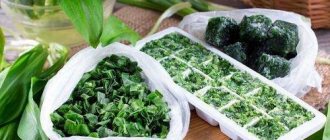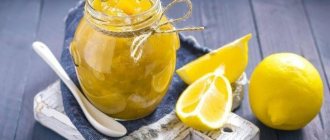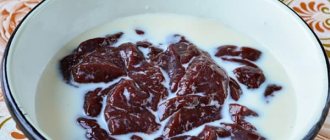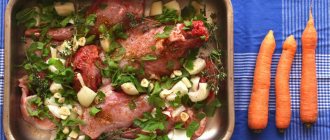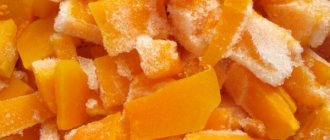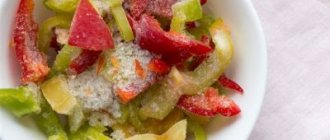A simple, tasty and healthy preparation, without sterilization, will be a godsend for those housewives whose family loves stuffed peppers, because in winter this vegetable is worth its weight in gold, and you really want to please your loved ones with something delicious.
In our cellar we always stock several three-liter jars of peppers for stuffing. In order not to bother with cabbage rolls, we put the minced meat into prepared vegetable cups, put them in the oven for half an hour and the dish is ready. We suggest you stock up on peppers for future use to make your daily routine easier.
How to preserve bell peppers for the winter
1. To prepare the preparation, we will need ripe bell peppers of various colors: green, yellow, red. We wash it from dirt and dust. We cut off the stalks, take out and throw away the seeds; we won’t need them anymore.
2. Place the fruits in a previously prepared, clean, sterilized three-liter jar. put the peppers in each other, it will save space. I will write how to prepare containers for preservation after the recipe itself.
3. Boil water. Scald the peppers with boiling water and let stand for 25-30 minutes.
After 25-30 minutes, pour the water into the pan. Bring to a boil again.
4. Put the required amount of sugar, salt and vinegar into the jar. Pour boiling water into a jar and roll up. Turn the workpiece upside down and wrap it in something warm, such as an old blanket, fur coat or rug. Leave it like this until it cools completely. Then put it in the cellar or pantry. This workpiece is stored perfectly in a city apartment. Only under one condition: peppers for stuffing in jars for the winter should not be exposed to direct sunlight, and the jars should not be placed near a heat source, radiator, or heater.
And finally, a couple of tips
- Cleanliness is the key to preventing jars from swelling. Jars, lids, keys for rolling, spoons, knives, plates - wash everything thoroughly with soda. After washing, rinse with boiling water and dry.
- Do everything as quickly as possible. Immediately after sterilization, add the peppers and immediately fill them with marinade. Having lost speed, we lose temperature. We'll have to do everything again.
- The quality of the ingredients comes first. Ingredients without spoilage are the guarantee that the preservation will not spoil.
- Do everything with love. Then each jar will carry positive energy and give positive emotions while eating. Have fun preparing peppers for stuffing for the winter!
How to sterilize jars for preparations
In order for the workpiece to be stored well all winter, you should not neglect these rules and should only roll the workpieces into clean jars. The jars should be washed well with baking soda or laundry soap. Rinse them well under running water. It is not advisable to use chemical detergents.
Now the jars need to be sterilized over steam, in the microwave (as described in detail in this recipe) or in the oven.
- How to sterilize jars in the oven? Place clean jars on a baking sheet or wire rack and place in the oven. Turn on the oven at 100-150 degrees for 20 minutes. Important! The jars should be placed in a cold oven, and only then turned on to the desired temperature. After all, due to temperature changes, glass containers can burst. Sterilization of empty jars in the oven is faster, because you do not need to stand over each jar and wait the required time.
- How to sterilize jars over steam? Pour 1 liter of water into a saucepan, put it on fire, and place a special circle on the top of the saucepan for sterilizing jars. Bring the water to a boil, place the jar on the pan, and leave over the steam for 5-7 minutes. Carefully remove and put on the next jar.
We also don’t forget that you need to sterilize metal lids; to do this, put all the lids in a saucepan, fill them with water, put on fire and after the liquid boils, boil for another 5-10 minutes.
In these simple ways you can prepare containers for preparations for the winter; these methods are suitable not only for preparing peppers for stuffing for the winter, but also for everyone else.
Recommendations
When preparing sweet peppers in winter, the following recommendations from experts may be useful:
Vegetables harvested or purchased for freezing must be processed as quickly as possible, before they begin to wither.- If you bought or collected peppers not only for freezing, but also for preservation, you first need to do freezing, and then pickling.
- Thawed vegetables cannot be re-frozen. Because of this, it is very important to correctly sort the pepper into portions in order to defrost it exactly as much as is needed to prepare one dish.
- To freeze vegetables, you can use not only ordinary plastic bags, but also those with a zip fastener, as well as plastic food containers with a lid.
Freezing peppers for stuffing for the winter
How nice it is in the cold winter to pamper yourself and your loved ones with dishes made from fresh vegetables. For example, stuffed bell peppers. Tasty, healthy, but... In winter, such food can take a toll on the family budget. The difference between the price of fresh peppers in the summer and in the “off season” is painfully large.
However, there is a way out. Nobody bothers you to buy fresh bell peppers in the summer and prepare enough of them for the winter. Moreover, under certain conditions or processing, this vegetable is preserved very well.
This is perhaps the easiest way to prepare peppers for stuffing for the winter. To freeze, you can take peppers of any color you like. However, not every pod is suitable. The pepper should not be limp and, of course, not spoiled. So before you start harvesting, it’s worth inspecting each specimen.
Everything else is simple. Wash the vegetables, cut off the top and stem and remove all the seeds. After this, lower the peppers into boiling (or lightly salted) water for 2-3 minutes. This is done so that the vegetables soften slightly.
Then you need to remove the pepper from the water, drain the liquid that got inside and let it cool. The pods prepared in this way must be carefully placed one into another, collecting 4-5 pieces in “batches”. Each “stack” of vegetables should be placed in a separate bag and placed in the freezer.
This storage method is convenient because it saves a lot of usable space in the refrigerator. In principle, you can freeze already stuffed peppers. True, they take up a lot of space. So this method of preparation is not always advisable.
Conservation
If the refrigerator does not allow you to freeze a lot of vegetables, then you can prepare peppers in another way - roll them into jars. This form of preserving peppers for stuffing for the winter is no less effective than freezing.
For such preservation you will need the following amount of ingredients (calculation is given for 1.5-2 kg of vegetables): • bell pepper – 1.5-2 kg of small or medium-sized pods (optional); • bay leaf – 3-4 leaves; • black and allspice – 5-6 peas each; • greens (dill or parsley) – 1 sprig; • salt – 1 tablespoon and a little to taste; • sugar – 2 teaspoons; • vinegar (9%) – 2 tablespoons.
Just like for freezing peppers, you need to cut off the stalks, clean out all the seeds, and then thoroughly rinse each vegetable. Boil water in a large saucepan, salt it to taste, and put the peppers in there for 1-2 minutes. There is no need to turn off the fire under the pan; let the water continue to boil. Then, using a fork, remove the peppers one at a time and drain the water from each and set aside to cool.
While the vegetables are cooling, you can prepare the jars. They need to be washed and sterilized for about 20-25 minutes. After this, you can put the peppers in the jars. You should not pack vegetables too tightly. This can damage them and make them unsuitable for stuffing. When this stage is completed, you can begin preparing the marinade. To do this, you need to boil 1.5 liters of water, add salt, pepper (peas), sugar, herbs and boil it all for 5 minutes.
All that remains is to add vinegar to the jars, pour in the marinade and roll them up with sterilized lids. If for some reason there is not enough marinade, then you can add plain boiling water from a kettle to the jars.
Next, according to tradition, the jars must be placed on the lids (turned over), wrapped in a warm blanket and left until completely cooled, and then transferred to the main storage location.
Peppers for stuffing with tomato juice for the winter
Another option for canning peppers for stuffing for the winter offers a non-standard preparation. In this case, the peppers will be rolled into jars in tomato sauce. First you need to prepare tomato juice. This is done simply. The tomatoes are cut into pieces, placed in a saucepan and cooked for about 60 minutes. There is no need to add water; tomatoes will already provide a lot of liquid. The main thing is to stir the contents of the saucepan regularly. The finished tomato mass must be allowed to cool, and then rub through a sieve and put back on the fire and let it boil. The juice is ready. If desired, you can add salt and spices to it.
You can do it even simpler: dilute store-bought tomato paste with boiled water. But it is not recommended to take ready-made juices for harvesting peppers. You never know what the manufacturers put there. In any case, to prepare the peppers, the juice must be boiled.
Now it's time to start working on the peppers. Clean and rinse them in the same way as in other versions of blanks. Then the pods should be placed in boiling tomato juice and cooked for about 7 minutes. Then put the peppers into sterilized jars and pour in the juice in which they were boiled. You just need to make sure that there are no air bubbles left between the pods. After this, the jars can be rolled up.
*** It is worth noting that all of the above methods of preserving peppers for stuffing for the winter are equally effective, and after cooking they are in no way distinguishable from their fresh summer counterparts.
Preparing vegetables
To obtain high-quality preservation that retains the taste and benefits of fresh pepper, you need to complete the following preparatory steps:
- Select the required number of the freshest and most beautiful specimens without the slightest defect. They must have the same correct shape.
- Wash the vegetables thoroughly. And it is advisable to soak them in salted water for an hour. This will remove pesticides and other toxic substances.
- Carefully cut off the piece that is adjacent to the stalk. This part is not needed for stuffing; moreover, it is in it that toxic chemicals are most concentrated.
- Completely remove seeds from fruits.
Shelf life
Freezing for storing bell peppers is a method that allows you to store them for as long as possible
save the harvest.
The shelf life of frozen peppers is 12 months.
. Thus, for the entire period until the next pepper harvest, you can provide yourself with it using this method.
Freezing whole
for subsequent stuffing, it is especially good as a preparation for the winter.
If you find an error, please select a piece of text and press Ctrl+Enter
.
I would like to bring to your attention a recipe for pickled bell peppers, which you can eat as an independent dish or use for stuffing with minced meat with the addition of rice and vegetable fillings. For stuffing, you should make preparations from whole peppers, and for salads and side dishes, you can cut them into large pieces.
My mom always has a jar of this pepper on hand. It can be sealed in jars of different sizes; it is convenient for our family to prepare canned bell peppers in 3-liter jars.


